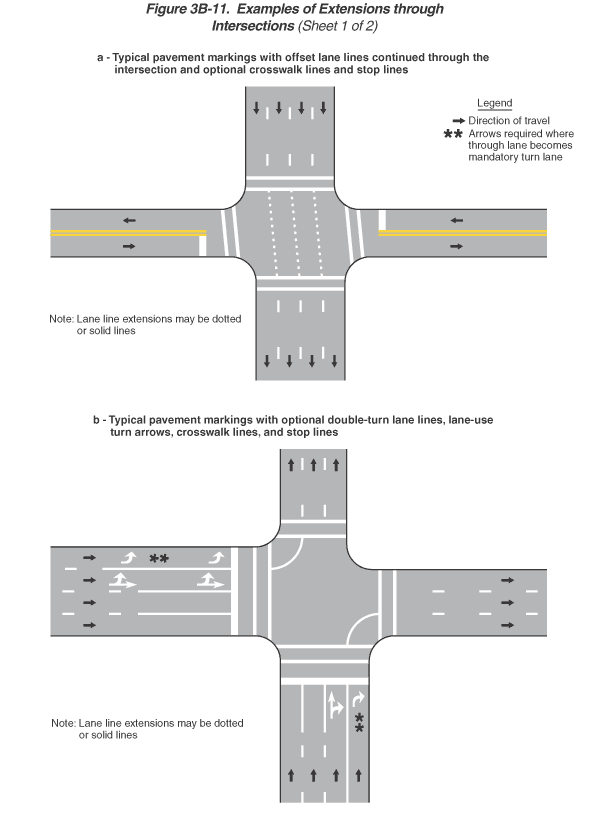|

Figure 3B-11. Examples of Extensions through Intersections (Sheet
1 of 2)
This figure illustrates four examples of extensions through intersections
or interchanges, (a), (b), (c), and (d). The figure is composed
of two sheets.
- Sheet 1 of the figure shows two roadway intersections, examples
(a) and (b). A legend shows a black arrow indicating the direction
of travel in the lanes and a double asterisk denoting "arrows
required where through lane becomes mandatory turn lane":
- The first example is labeled "a - Typical pavement markings
with offset lane lines continued through the intersection and
optional crosswalk lines and stop lines" A note states "Lane
line extensions may be dotted or solid lines":
- This figure shows the intersection of a two-lane horizontal
roadway with a vertical roadway with four southbound lanes.
Arrows show that the direction of travel is two way on the
horizontal two-lane roadway and one way to the south on the
vertical four-lane roadway. The two-lane roadway has a double
solid yellow line dividing the two lanes and solid white stop
lines across the approach lane on each side of the intersection.
- The four lanes on the south side of the intersection are
offset to the right of the four lanes on the north side of
the intersection. Broken white lines separate the four lanes
on each side of the intersection. Through the intersection,
the lanes are separated by dotted white lines.
- On each side of the intersection on each roadway are two
parallel solid white lines denoting crosswalks.
- The second example is labeled "b - Typical pavement markings
with optional double-turn lane lines, lane-use turn arrows, crosswalk
lines, and stop lines" A note states "Lane line extensions
may be dotted or solid lines":
- This figure shows the intersection of a three-lane horizontal
roadway with a three-lane vertical roadway. Arrows show that
the direction of travel is one way to the east on the horizontal
roadway and one way to the north on the vertical roadway.
- The left side of the horizontal roadway is composed of two
through lanes (the right and middle lanes), a combination
straight or left-turn lane, and an added fourth (left-turn
only) lane, and a straight or left-turn lane. The two turn
lanes are separated from each other by a solid white line,
and the through lanes are separated from each other by broken
white lines. White turn arrows are marked in the turn lanes.
A double asterisk denotes that the turn arrows are required
for the far left turn lane. As the lanes approach the intersection,
the broken white lines become solid white lines. A solid white
stop line is marked across all eastbound and northbound approach
lanes at the intersection. The solid white line separating
the far left turn lane from the combination through-left turn
lane is extended through the intersection, starting beyond
the west crosswalk and curving 90 degrees to the left and
is omitted inside the north side crosswalk, to join the lane
line that separates the left and center lanes of the northbound
roadway on the north side of the intersection. On the east
side of the intersection, there are three through lanes separated
by broken white lines.
- The part of the northbound roadway on the south side of
the intersection is composed of two through lanes (the left
and middle lanes), a combination through or right turn lane,
and an added fourth right-turn lane. The two turn lanes are
separated from each other by a solid white line, and the through
lanes are separated from each other by broken white lines.
White turn arrows are marked in the turn lanes. A double asterisk
denotes that the turn arrows are required for the far right
turn lane. As the lanes approach the intersection, the broken
white lines become solid white lines. A solid white stop line
is marked across all northbound and eastbound approach lanes
at the intersection. The solid white line separating the far
right turn lane from the combination through-right turn lane
is extended through the intersection, starting beyond the
south crosswalk and curving 90 degrees to the right and is
omitted inside the east side crosswalk, to join the lane line
that separates the right and center lanes of the eastbound
roadway on the east side of the intersection. On the north
side of the intersection, there are three through lanes separated
by broken white lines.
- On each side of the intersection on each roadway are two
parallel solid white lines denoting crosswalks.
Continue to: Sheet 2
Back
to Chapter 3B
|

